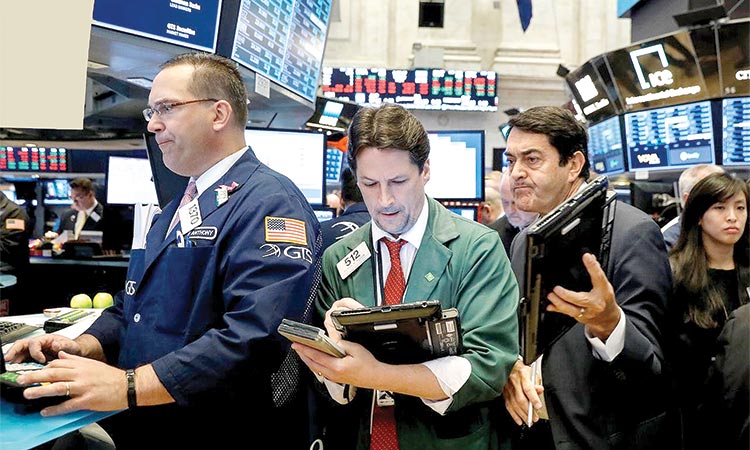Global growth worries, Chinese tech rout drag Wall Street lower

Shoppers wear face masks to protect against the spread of the coronavirus after the COVID-19 alert was raised to level 3 in Taipei, Taiwan, on Thursday. Associated Press
Wall Street’s main indexes fell sharply on Thursday as the spread of the COVID-19 Delta variant cast doubts over an economic recovery, while a rout in Chinese tech stocks appeared to have spilled across markets.
Investors globally turned wary of risk. Equities fell and bond prices rallied on worries about Beijing’s crackdown on foreign-listed Chinese firms and a sustained global economic recovery.
Chinese ride-hailing giant Didi Global Inc, which has been at the center of a selloff after its app was taken down by Beijing, fell 6%.
Other US-listed Chinese stocks fell, tracking steep losses in China and Hong Kong, with e-commerce giant Alibaba Group Holding Ltd sliding 3.9% and internet search engine Baidu Inc down 3.8%.
“What you saw with Didi this week really spooked investors because you have a concern now...that we don’t know what the regulatory proposals are going to look like,” said Thomas Hayes, chairman of Great Hill Capital in New York.
“Until there’s clarity and the Chinese government moderates its stance, investors will dump holdings and ask questions later.”
Picture used for illustrative purpose only.
Meanwhile, Atlanta Federal Reserve President Raphael Bostic warned that a spike in the highly infectious coronavirus variant could hamper a US economic recovery.
Minutes of the central bank’s June meeting released on Wednesday showed the Fed officials felt a U.S. recovery had a long way to go and they may not be ready yet to move on tightening policy.
Indeed, the Labor department’s report showed weekly jobless claims unexpectedly rose to 373,000 for the week ended July 3. Economists polled by Reuters had forecast 350,000 applications for the latest week.
The CBOE Volatility index, also known as Wall Street’s fear gauge, jumped 3.1 points to its highest level in over two weeks.
Stocks that led much of Wall Street’s rally this year and those that stand to benefit the most from an economic rebound were under pressure.
The S&P 500 banks sank 2.6%, tracking a fall in the 10-year Treasury yield to 1.25%.
All the 11 major S&P 500 sector indexes were in the red, with cyclical players such as energy and industrials tumbling along with growth sectors including consumer discretionary and technology.
The FAANG group of shares, which are typically preferred during a low-rate environment dropped between 0.3% and 2.1%. They had sent the Nasdaq and S&P 500 to record highs in the previous session.
At 10:03 a.m. ET, the Dow Jones Industrial Average was down 392.30 points, or 1.13%, at 34,289.49, the S&P 500 was down 56.93 points, or 1.31%, at 4,301.20 and the Nasdaq Composite was down 211.24 points, or 1.44%, at 14,453.83.
Picture used for illustrative purpose only.
Tesla Inc declined 2.1% after the electric-vehicle maker said it sold fewer China-made vehicles in June compared with May. Investors also awaited the start of second-quarter earnings, with big lenders kicking off the season next week. Declining issues outnumbered advancers for a 8.09-to-1 ratio on the NYSE and for a 6.20-to-1 ratio on the Nasdaq. The S&P index recorded eight new 52-week highs and no new low, while the Nasdaq recorded 13 new highs and 133 new lows.
Oil prices rose on Thursday, rebounding from early losses after U.S. government data showed a much bigger drop than expected in crude and gasoline inventories.
Still, Brent prices remained as $5 a barrel below Monday’s close, as traders worried global crude supplies. Early in the session, both contracts fell to their lowest in about three weeks.
US crude inventories fell by 6.9 million barrels last week to 445.5 million barrels, Energy Information Administration data showed. Analysts had expected a 4 million-barrel drop.
Gasoline stocks fell by 6.1 million barrels in the week to 235.5 million barrels, the EIA said. Analysts had forecast a 2.2 million-barrel drop.
“The report is bullish, there’s no doubt,” said Tony Headrick, energy market analyst at CHS Hedging. “We did see a very large increase in total gasoline supplied, which would have led up to the Friday before the Fourth of July weekend.”
Copper prices dipped on Thursday after the U.S. Federal Reserve confirmed plans to tighten monetary policy sooner than expected.
The Fed’s plans, which would reduce liquidity in the market, has helped to drag back copper prices from the $10,747.50 a tonne record high touched in May.
Benchmark three-month copper on the London Metal Exchange (LME) was down 1.7% at $9,297.50 in official trading.
The Fed’s switch to a more hawkish stance was signalled at the its June policy meeting, pushing the dollar higher and making assets priced in the greenback more expensive for holders of other currencies.
“The (Fed’s minutes) saw a continuation of the sell-off that started June 16 when the Fed surprisingly sent hawkish signals by bringing forward rate hike projections,” said ING analyst Wenyu Yao.
“Over the last two weeks the macro market is seeing a capitulation of reflation trade ... that is giving a lot of pressure to metals, especially copper.”








